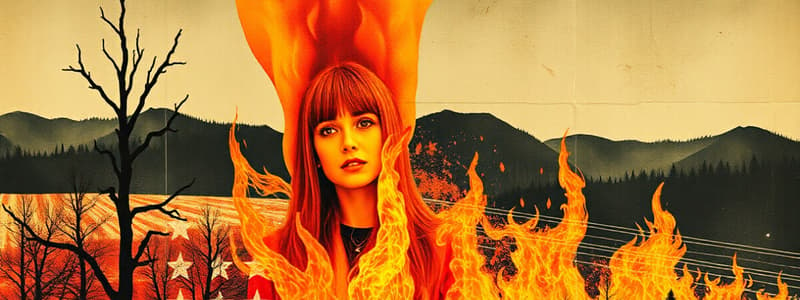Podcast
Questions and Answers
What is the primary advantage of using drones in wildfire management for improved resource allocation?
What is the primary advantage of using drones in wildfire management for improved resource allocation?
- Drones are able to provide a quick map fire extent and predict spread, improving allocation. (correct)
- Drones are most effective after a wildfire has already been contained.
- Drones are only effective during daylight hours because of sensor tech limitations.
- Drone deployment offers a very minimal impact and can cause confusion during active firefighting efforts.
To enhance the functionality of strategic wildfire barriers, what added feature would be the MOST valuable?
To enhance the functionality of strategic wildfire barriers, what added feature would be the MOST valuable?
- Solely depending on manual barriers like earthworks.
- Incorporating systems designed to extinguish cigarettes. (correct)
- Concentrating efforts on deflecting flames and embers alone.
- Giving priority to aesthetic design, by ensuring integration with the natural landscape.
When considering the utility of automated water solutions, what statement is the MOST accurate?
When considering the utility of automated water solutions, what statement is the MOST accurate?
- Automated solutions offer little benefit and are just a gimmick.
- Automated systems are only effective in areas prone to flash floods.
- Automated systems offer an efficient approach to ignition prevention by combining sensors, sprinklers and weather data. (correct)
- Manual application of water is more effective and cheaper than automated solutions.
In order to improve current wildfire escape strategies, which element should be emphasized?
In order to improve current wildfire escape strategies, which element should be emphasized?
What is the most valid statement regarding the combination of AI-driven surveillance and robotic clearing for mitigating wildfire risk?
What is the most valid statement regarding the combination of AI-driven surveillance and robotic clearing for mitigating wildfire risk?
Which statement is most valid regarding the implementation of fire-resistant landscaping around homes?
Which statement is most valid regarding the implementation of fire-resistant landscaping around homes?
Which statement exhibits the most validity regarding the use of autonomous bulldozers in constructing firebreaks?
Which statement exhibits the most validity regarding the use of autonomous bulldozers in constructing firebreaks?
When considering improvements to wildfire predictive risk assessments, which action is most valid?
When considering improvements to wildfire predictive risk assessments, which action is most valid?
What is the most valid consideration when deploying robotic systems for wildfire defense in remote areas?
What is the most valid consideration when deploying robotic systems for wildfire defense in remote areas?
Regarding the use of drones for wildfire monitoring, which factor is most important when assessing their effectiveness?
Regarding the use of drones for wildfire monitoring, which factor is most important when assessing their effectiveness?
Which of the following strategies is the most valid approach to enhancing community resilience against wildfires?
Which of the following strategies is the most valid approach to enhancing community resilience against wildfires?
What factor is most valid when evaluating the potential for using AI to optimize resource allocation during a large-scale wildfire event?
What factor is most valid when evaluating the potential for using AI to optimize resource allocation during a large-scale wildfire event?
What is the most accurate assessment of early wildfire detection system capabilities?
What is the most accurate assessment of early wildfire detection system capabilities?
Concerning fire-resistant construction materials and community resilience, which statement is most accurate?
Concerning fire-resistant construction materials and community resilience, which statement is most accurate?
Regarding strategically placed manmade geysers for wildfire mitigation, which characteristic is most valid?
Regarding strategically placed manmade geysers for wildfire mitigation, which characteristic is most valid?
When considering the large employment of 'leaf' blowers and vacuums for wildfire prevention, what concern is most valid?
When considering the large employment of 'leaf' blowers and vacuums for wildfire prevention, what concern is most valid?
What is a significant limitation of relying solely on prescribed burns for wildfire risk reduction?
What is a significant limitation of relying solely on prescribed burns for wildfire risk reduction?
When evaluating household actions to increase wildfire resilience, what approach is most effective?
When evaluating household actions to increase wildfire resilience, what approach is most effective?
What is the most accurate statement regarding the use of fire shelters by wildland firefighters?
What is the most accurate statement regarding the use of fire shelters by wildland firefighters?
Considering community-level strategies for wildfire mitigation, which approach is likely to be MOST effective?
Considering community-level strategies for wildfire mitigation, which approach is likely to be MOST effective?
When considering the use of leaf blowers and vacuums, what ecological factor requires primary consideration?
When considering the use of leaf blowers and vacuums, what ecological factor requires primary consideration?
Which of the following statements best describes a key factor in determining the effectiveness of strategic thinning for wildfire prevention?
Which of the following statements best describes a key factor in determining the effectiveness of strategic thinning for wildfire prevention?
What is the most critical requirement for biologically engineered materials intended to mitigate wildfire spread?
What is the most critical requirement for biologically engineered materials intended to mitigate wildfire spread?
As robotic teams become increasingly involved in wildfire management, which ethical concern should be given the most consideration?
As robotic teams become increasingly involved in wildfire management, which ethical concern should be given the most consideration?
What valid factor most determines the successful deployment of remote-controlled atmospheric water generation systems?
What valid factor most determines the successful deployment of remote-controlled atmospheric water generation systems?
Evaluating different techniques for wildfire management, what is the most important factor when introducing new materials into the environment?
Evaluating different techniques for wildfire management, what is the most important factor when introducing new materials into the environment?
What primary consideration should guide decisions regarding resource allocation for wildfire prevention versus suppression?
What primary consideration should guide decisions regarding resource allocation for wildfire prevention versus suppression?
Considering the application of prescribed burns, what is the most essential element for conducting them safely and effectively?
Considering the application of prescribed burns, what is the most essential element for conducting them safely and effectively?
Under which conditions is remote-controlled atmospheric water generation most feasible as a localized water source?
Under which conditions is remote-controlled atmospheric water generation most feasible as a localized water source?
What is the primary factor determining the effectiveness of sensors deployed with speaker arrays for automated localized fire suppression?
What is the primary factor determining the effectiveness of sensors deployed with speaker arrays for automated localized fire suppression?
How does integrating thermal imaging into wearable gear most validly improve firefighter safety?
How does integrating thermal imaging into wearable gear most validly improve firefighter safety?
What is the most significant advantage of using rapid-response aerial flame-retardant drone systems for wildfire management?
What is the most significant advantage of using rapid-response aerial flame-retardant drone systems for wildfire management?
In the context of AI-driven drones for spot fire response, what strategy most validly addresses wildfires?
In the context of AI-driven drones for spot fire response, what strategy most validly addresses wildfires?
What is a crucial component to consider when creating wildfire barriers?
What is a crucial component to consider when creating wildfire barriers?
Why does wearable thermal vision improve safety?
Why does wearable thermal vision improve safety?
What is the predominant advantage of Aerial Flame-retardant?
What is the predominant advantage of Aerial Flame-retardant?
Flashcards
Drones in Wildfire Management
Drones in Wildfire Management
Drones can quickly map fire and predict the spread patterns.
Wildfire Barrier Refinements
Wildfire Barrier Refinements
Systems to extinguish cigarettes can be added to strategic wildfire barriers
Automated Water Solutions
Automated Water Solutions
Solutions that combine sensors, sprinklers, and weather data to prevent ignition.
Improved Escape Strategies
Improved Escape Strategies
Signup and view all the flashcards
Wildfire Risk Assessment
Wildfire Risk Assessment
Signup and view all the flashcards
Vegetation Management
Vegetation Management
Signup and view all the flashcards
Interdisciplinary Collaboration
Interdisciplinary Collaboration
Signup and view all the flashcards
Community Education
Community Education
Signup and view all the flashcards
AI + Robotics for Wildfires
AI + Robotics for Wildfires
Signup and view all the flashcards
Fire-Resistant Landscaping
Fire-Resistant Landscaping
Signup and view all the flashcards
Autonomous Bulldozers
Autonomous Bulldozers
Signup and view all the flashcards
Improve Wildfire Prediction
Improve Wildfire Prediction
Signup and view all the flashcards
Dynamic Wildfire Mitigation
Dynamic Wildfire Mitigation
Signup and view all the flashcards
Fire-Resistant Landscaping Utility
Fire-Resistant Landscaping Utility
Signup and view all the flashcards
Autonomous Bulldozers Effectiveness
Autonomous Bulldozers Effectiveness
Signup and view all the flashcards
Enhancing Wildfire Assessment
Enhancing Wildfire Assessment
Signup and view all the flashcards
Effective wildfire detection
Effective wildfire detection
Signup and view all the flashcards
Fire-resistant building materials.
Fire-resistant building materials.
Signup and view all the flashcards
Manmade Geysers
Manmade Geysers
Signup and view all the flashcards
Leaf blowers impacting biodiversity
Leaf blowers impacting biodiversity
Signup and view all the flashcards
Integrated wildfire risk reduction
Integrated wildfire risk reduction
Signup and view all the flashcards
Early Detection and Evacuation
Early Detection and Evacuation
Signup and view all the flashcards
Limits of fire-resistant materials
Limits of fire-resistant materials
Signup and view all the flashcards
Geysers Placement
Geysers Placement
Signup and view all the flashcards
Leaf Blower Impact
Leaf Blower Impact
Signup and view all the flashcards
Strategic Thinning Value
Strategic Thinning Value
Signup and view all the flashcards
Biologically Engineered Materials
Biologically Engineered Materials
Signup and view all the flashcards
Robotic Wildfire Teams
Robotic Wildfire Teams
Signup and view all the flashcards
Remote Atmospheric Water Gen
Remote Atmospheric Water Gen
Signup and view all the flashcards
Prescribed Burns
Prescribed Burns
Signup and view all the flashcards
Post-fire Restoration
Post-fire Restoration
Signup and view all the flashcards
Remote Water Generation
Remote Water Generation
Signup and view all the flashcards
Sensor Accuracy on Speakers
Sensor Accuracy on Speakers
Signup and view all the flashcards
Wearable Thermal Imaging
Wearable Thermal Imaging
Signup and view all the flashcards
Flame-Retardant Drone Advantage
Flame-Retardant Drone Advantage
Signup and view all the flashcards
AI Drones for Spot Fires
AI Drones for Spot Fires
Signup and view all the flashcards
Wildfire Risk Factors
Wildfire Risk Factors
Signup and view all the flashcards
Interdisciplinary Wildfire Approach
Interdisciplinary Wildfire Approach
Signup and view all the flashcards
Study Notes
- These notes cover different aspects of wildfire management strategies and technologies.
Drones in Wildfire Management
- Drones equipped with sensors enhance resource allocation by quickly mapping fire extent and predicting spread patterns.
Strategic Wildfire Barriers
- Strategic wildfire barriers are enhanced when they incorporate systems to extinguish cigarettes to prevent ignitions.
Automated Water Solutions
- Combines sensors, sprinklers, and weather data, offering a holistic approach to ignition prevention.
Escape Strategies During Wildfires
- Focus on real-time navigation systems that show safe evacuation routes.
AI-Driven Surveillance and Robotic Clearing
- Combining AI-driven surveillance with robotic clearing creates a dynamic solution to mitigate wildfire risk.
Fire-Resistant Landscaping
- Integrating native, fire-resistant landscaping materials around homes is valuable for slowing fire spread.
Autonomous Bulldozers
- Autonomous bulldozers are effective when guided by real-time thermal mapping from drones, prioritizing areas of greatest risk.
Wildfire Predictive Risk Assessments
- The reliability can be enhanced by integrating real-time environmental data from sensor networks.
Early Wildfire Detection Systems
- Early detection systems are most effective when integrated with automated suppression technologies and prompt evacuation protocols.
Fire-Resistant Construction Materials
- Fire-resistant construction materials reduce building ignition rates during wildfires, enhancing community resilience.
Manmade Geysers
- Small scale strategically placed manmade geysers efficiently douse areas recently scorched to quickly reduce fire's forward movement.
Leaf Blowers and Vacuums
- Implementation should consider the potential impact on local biodiversity and soil health.
Strategic Thinning
- Sound strategic thinning implementation relies on sustainable forestry practices that promote long-term forest health and biodiversity.
Biologically Engineered Materials
- Employment of biologically engineered materials should meet rigorous safety standards and offer demonstrated fire-resistant properties.
Robotic Teams
- Deployment faces ethical considerations regarding job displacement and environmental impact.
Atmospheric Water Generation
- Remote-controlled atmospheric water generation is feasible under specific environmental conditions, offering a local water source.
Sensors with Speaker Arrays
- The validity of sensors attached to speaker systems depends on high accuracy of data for determining direction of flames.
Thermal Imaging
- Integrating thermal imaging into wearable gear for firefighters enhances safety and reduces risk.
Aerial Flame-Retardant Drone Systems
- Provides significant advantages in rapidly deploying aerial coverage to lower fire risk.
AI-Driven Drones for Spot Fire Response
- Using AI-driven drones is most valuable when combined with strategic ember sensors to rapidly respond to spot fires.
Studying That Suits You
Use AI to generate personalized quizzes and flashcards to suit your learning preferences.




